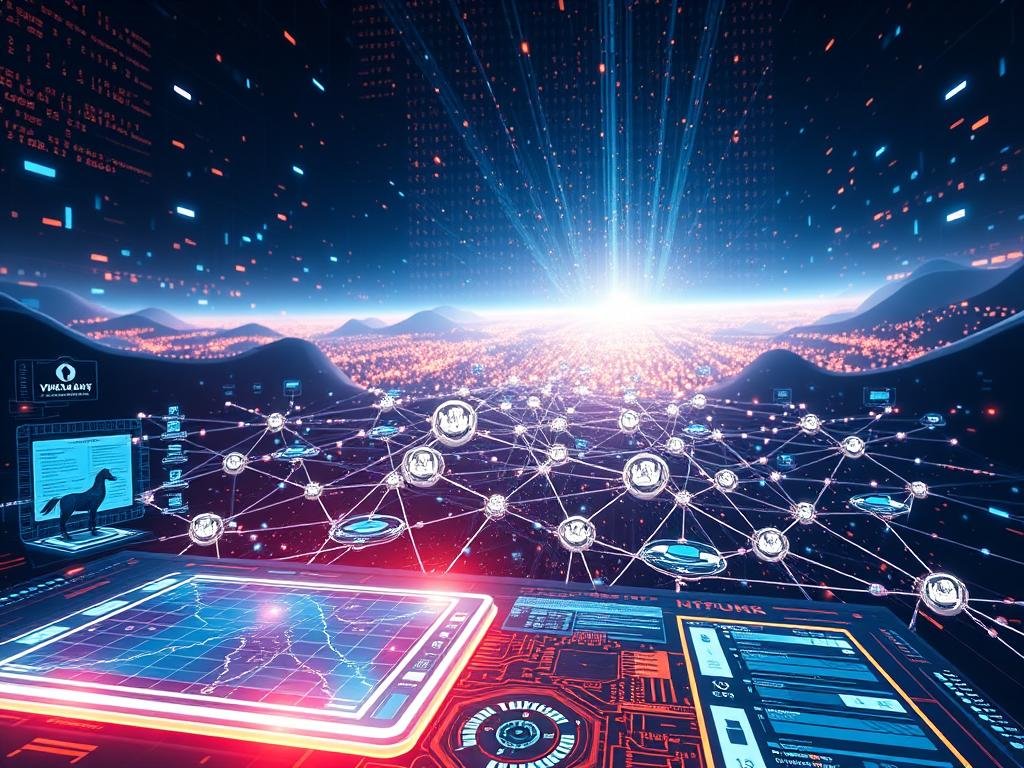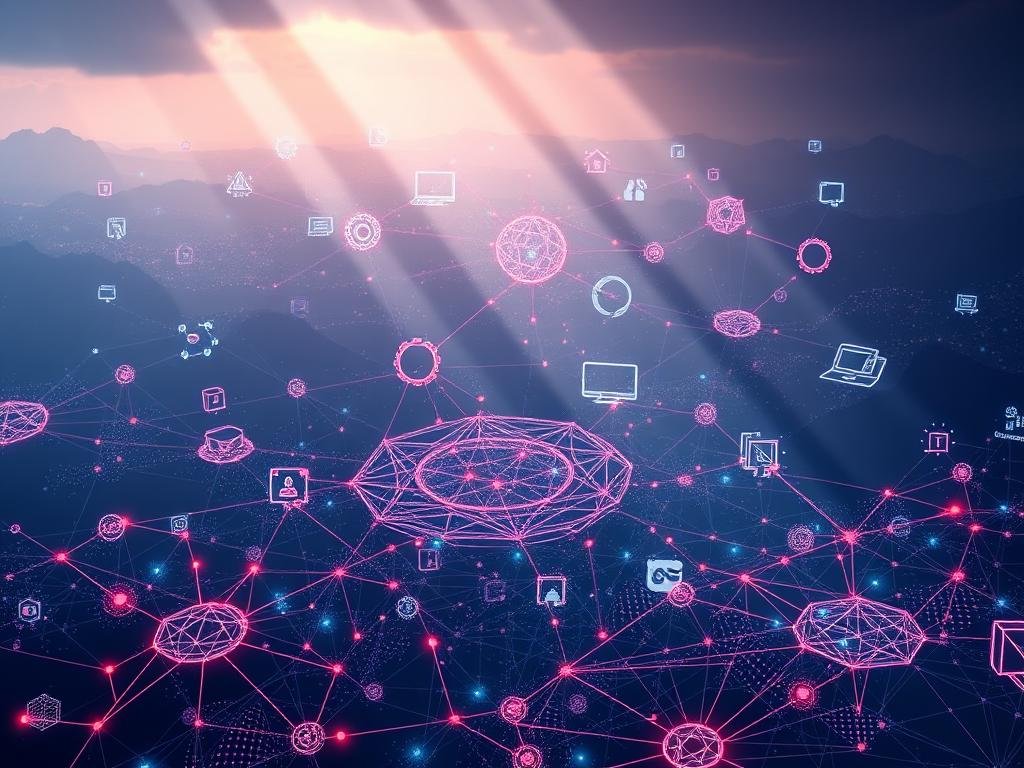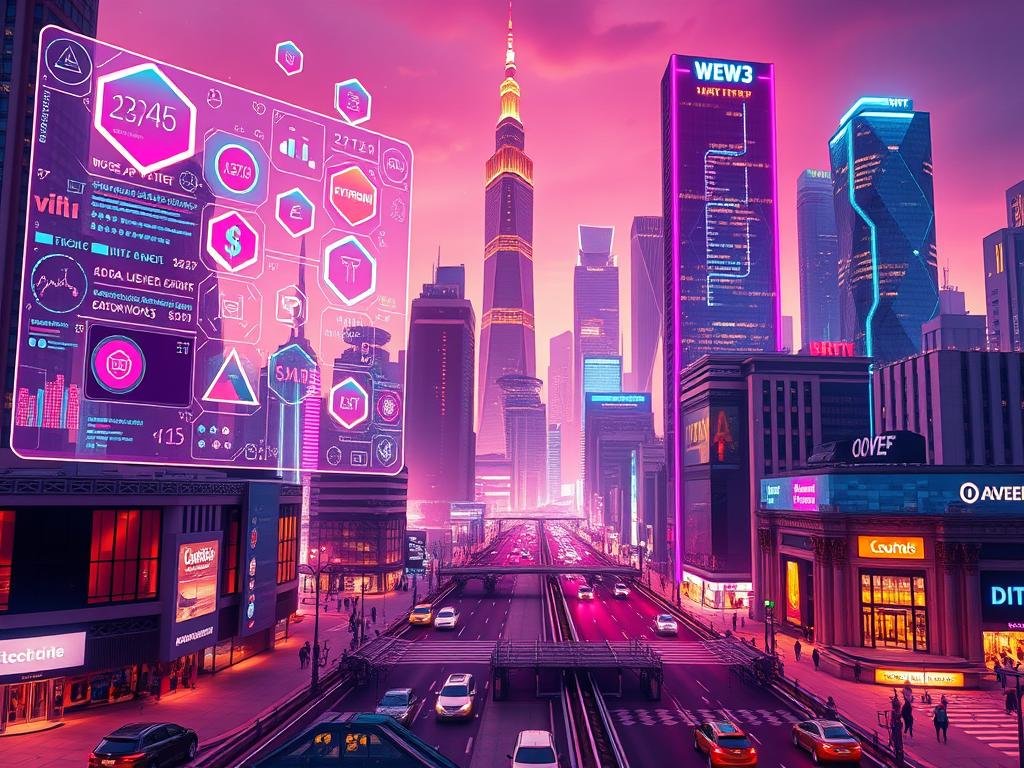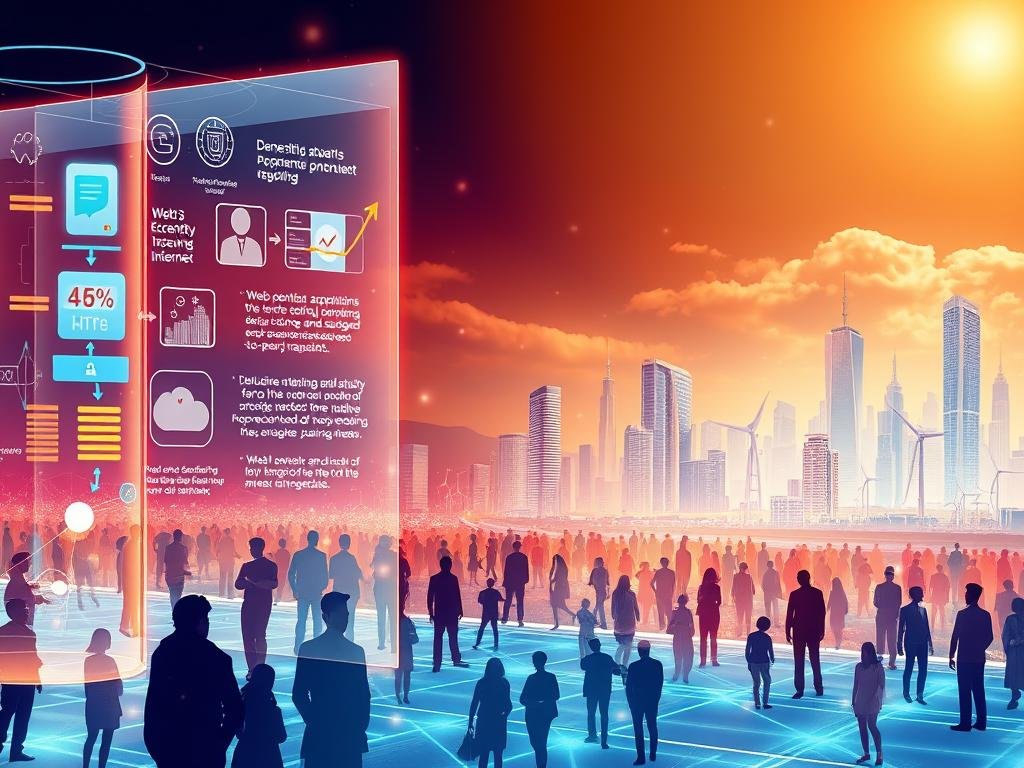Imagine a future where the internet is free from big corporations’ control. It’s a decentralized universe where you own your data. This is what Web3 promises, the next step in the internet’s evolution. It uses blockchain technology for a more open and user-focused online world. By 2025, over $27 billion will be spent on decentralized projects, showing a big move towards this new way.
You’re part of a growing group checking out Web3 and its uses. From decentralized finance (DeFi) to non-fungible tokens (NFTs), there’s a lot to explore. This guide will help you understand web3 technology and its impact on the internet’s future. For more, check out Web3 applications.
Key Takeaways
- The decentralized internet, powered by Web3, is expected to attract significant investment by 2025.
- Blockchain technology is the backbone of Web3, enabling transparent and secure online interactions.
- Web3 applications are diversifying, with notable growth in DeFi, NFTs, and the metaverse.
- Understanding Web3 is key for navigating the internet’s future.
- The move to decentralization will deeply change how we use the internet.
Understanding Web3: The Next Evolution of the Internet
Web3 is the next big thing in the internet world. It’s all about decentralization and user control. This change makes the internet safer, more open, and focused on users.
The Core Principles of Web3
Web3 is built on three main ideas: decentralization, trustlessness, and permissionlessness. Decentralization means no single person controls data or apps, making it safer. Trustlessness uses cryptography to keep interactions safe, without needing a third party. Permissionlessness lets anyone join without needing permission from someone else.
Blockchain technology makes all this possible. It ensures interactions are secure and can’t be changed. This way, Web3 apps work on their own, giving users full control over their data and stuff.
How Web3 Differs from Traditional Internet Models
Web3 is different from Web2.0 because it’s decentralized. Users own their data, not companies. This changes how we use the internet, putting users in charge instead of corporations.
The move from Web2 to Web3 is more than just tech updates. It’s about making the internet fairer. Web3 focuses on users, privacy, and safety, which is a big change from the old internet ways.
The Evolution from Web1 to Web3: A Historical Perspective
The internet has gone through three main phases: Web1, Web2, and Web3. Each phase marked a big step forward. It’s important to know what made each era unique.

The Read-Only Era: Web1
Web1 started in the 1990s and was all about static websites. These sites gave information but didn’t let users interact much. It was a time when the internet was mostly for reading, not for creating or changing content.
The Interactive Social Web: Web2
Web2 came in the early 2000s and changed the game. It brought us social media, blogs, and the chance for users to share their own content. This era made the internet more interactive and engaging.
The Decentralized Ownership Web: Web3
Web3 is the newest phase, focusing on decentralized ownership and user control. It uses blockchain and cryptocurrencies to make the internet safer and fairer. This era aims to give users more power over their online presence.
The move from Web1 to Web3 is a big leap forward. It shows how far we’ve come from a simple, centralized internet to a more open and dynamic one. Understanding Web3’s history helps us see its full promise.
Blockchain: The Foundation of Web3 Technology
At the heart of Web3 is blockchain technology. It’s a decentralized ledger system changing the digital world. It stores data across many computers, not just one. This makes it hard to censor or cheat.
How Blockchain Enables Decentralization
Blockchain uses a distributed ledger to record transactions on a network of computers. This way, no one person controls the data. It’s more secure and open.
Key features of blockchain decentralization include:
- Distributed ledger technology
- Cryptographic security
- Immutable data storage
- Consensus mechanisms for validation
Smart Contracts and Their Role in Web3
Smart contracts are self-running contracts with rules written in code. They make sure things happen as planned, without middlemen.
For more on Web3 and its tech, check out this beginner’s guide to Web3.
Consensus Mechanisms Explained
Consensus mechanisms are key to blockchain. They help validate transactions and add new blocks.
Key Components of the Web3 Ecosystem
The Web3 ecosystem is made up of many important parts that work together. It’s like a big system where different technologies and apps help each other. This creates a strong and user-friendly internet.

Cryptocurrencies and Tokens
Cryptocurrencies and tokens are key in Web3. They help with transactions and encourage people to get involved. For example, you can use Ethereum to use Web3 apps. Tokens can also stand for special assets or services in a project or community.
Decentralized Applications (dApps)
Decentralized Applications, or dApps, run on blockchain networks. They are open-source, independent, and not controlled by one person. You can use dApps for many things, like finance, gaming, and social media. This way, you have more control over your data and how you interact online.
Non-Fungible Tokens (NFTs)
Non-Fungible Tokens, or NFTs, are unique digital items. They can be art, collectibles, or even real estate. NFTs are on blockchain networks, making them rare and real. You can buy, sell, and trade NFTs, opening up new chances for creators and collectors.
Decentralized Autonomous Organizations (DAOs)
Decentralized Autonomous Organizations, or DAOs, are groups led by blockchain. They are run by smart contracts, making decisions fair and open. By holding governance tokens, you can help decide how the organization grows.
In summary, the Web3 ecosystem includes cryptocurrencies, dApps, NFTs, and DAOs. Each part is important for a secure, open, and user-friendly internet. As you learn more about Web3, you’ll find new ways to interact online.
Real-World Web3 Applications and Use Cases
Web3 is growing fast, and we see it in many areas of life. It’s changing how we use the internet. This is thanks to its decentralized nature.

Decentralized Finance (DeFi)
DeFi is a big part of Web3. It uses blockchain to offer financial services without banks. This makes lending, borrowing, and trading easier and more open.
| DeFi Platform | Service Offered | Blockchain |
|---|---|---|
| Uniswap | Decentralized Exchange | Ethereum |
| Compound | Lending/Borrowing | Ethereum |
Web3 Gaming and the Metaverse
Web3 is changing gaming with the Metaverse. Players own their in-game items, which can be traded. This makes games more real and fun.
“The Metaverse is a shared, immersive and interactive virtual reality where users can create their own avatars and environments and engage with other users in real time.” –
Decentralized Social Media Platforms
Web3 is also making new social media. These platforms let users control their data. They aim to reduce big tech’s online power.
Key Features:
- Data ownership and control
- Decentralized governance
- Resistance to censorship
Web3 Identity and Data Ownership Solutions
Web3 helps with digital identity and data control. It uses blockchain to let people manage their data. They decide who sees it and when.
In conclusion, Web3 is changing our digital lives in many ways. It’s making finance, gaming, and social media better. These changes are moving us towards a more open internet.
Benefits and Opportunities of Web3
Web3 is changing the internet by giving users more control over their data. This move towards decentralization is more than just tech. It’s a push for a fairer, user-focused internet.
User Ownership and Control
One big benefit of Web3 is empowering users. You can now control your data, choosing who sees it and how it’s used. This is a big change from Web2, where big companies control everything.
“The future of the internet is not just about decentralization; it’s about giving users back their rights.” Many people agree with this, seeing how important it is to own your data.
Enhanced Privacy and Security
Web3 also means better privacy and security. It uses blockchain and cryptography to keep your data safe and private. This is a big step in protecting against data breaches and misuse.

New Economic Models and Incentives
The new economic models of Web3 are exciting. It introduces cryptocurrencies and tokens, opening up new ways to make money. Users can earn rewards by adding value to the system, like creating content.
For example, DeFi platforms are changing finance. They offer lending, borrowing, and trading without banks or other middlemen.
Looking at web3 opportunities, it’s clear Web3 can make the digital world more inclusive and fair.
Getting Started with Web3: A Beginner’s Roadmap
Starting your Web3 journey means learning about the basic tools and platforms. These tools help you interact with the decentralized internet. As a beginner, it’s important to take things slowly to really understand Web3.
Setting Up Your First Web3 Wallet
The first thing to do is set up a Web3 wallet. A Web3 wallet is key for managing cryptocurrencies and using dApps. Here’s how to set up your first Web3 wallet:
- Choose a reputable wallet provider that supports Web3.
- Download and install the wallet application or browser extension.
- Create a new wallet, securing your private keys and recovery phrase.
Your Web3 wallet opens the door to the decentralized world. It lets you use many Web3 services and apps.
Navigating Web3 Browsers and Platforms
Once you have a wallet, learn about Web3 browsers and platforms. Web3 browsers, like Brave, work with blockchain networks and dApps. To use Web3 browsers and platforms well:
- Install a Web3-enabled browser or use a compatible extension.
- Check out popular dApps and platforms to see what they offer.
- Find out how to link your Web3 wallet to these platforms.
Exploring these areas will help you use Web3 to its fullest.
Essential Web3 Resources and Communities
It’s also important to connect with Web3 resources and communities. These include:
- Online forums like Reddit’s r/web3, for Web3 discussions.
- Educational platforms with courses on blockchain and Web3.
- Social media groups focused on Web3 and decentralized tech.
Being part of these communities will help you learn more about Web3. It also keeps you up-to-date with the latest news and chances.
Challenges and Limitations in the Web3 Space
Web3 has a lot of promise but faces many challenges. It’s important to know what’s holding it back as we move towards a decentralized internet.
Technical Barriers and Scalability Issues
Scalability is a big problem for Web3. Blockchain networks can’t handle as many transactions as traditional systems. For example, Ethereum’s network has seen delays and high fees.
Developers are working on fixes like sharding and layer 2 solutions. These aim to make blockchain networks faster and more efficient.
Regulatory Uncertainties
Regulations are unclear in Web3, causing uncertainty. This makes it hard for developers and users to know what’s allowed. Without clear rules, innovation and adoption can slow down.
User Experience Hurdles
Web3 can be hard for new users to get into. Setting up wallets and understanding transactions can be overwhelming. Making these steps easier is key to getting more people involved.
Environmental Concerns
Some blockchain networks use a lot of energy, raising environmental concerns. The proof-of-work method is often criticized for its high energy use. Many are switching to proof-of-stake, which is more energy-friendly.
In summary, Web3 is promising but faces many hurdles. Overcoming these challenges is essential for its success. By addressing these issues, we can create a more decentralized and sustainable internet.
Conclusion: The Future of Web3 and Your Place in It
Web3 is changing how we use the internet, making it more open, safe, and focused on users. The future of Web3 looks bright, with chances for web3 adoption in many fields.
You now know the basics of Web3, its growth from earlier versions, and its main parts. As Web3 grows, it’s important to keep up with its progress and the chances it offers. The web3 opportunity to change how we interact online is huge, touching everything from money to games and social media.
By getting involved with Web3, you can lead this change. Whether you’re coding, investing, or just curious, there are many web3 opportunities to discover. As we go forward, being part of the Web3 world will help unlock its full power and shape the internet’s future.
FAQ
What is Web3 technology?
Web3 technology is the next step in the internet’s evolution. It’s all about decentralization, blockchain, and giving users control. This makes the system more secure and transparent.
How does Web3 differ from Web2?
Web3 is different because it’s decentralized. It uses blockchain for secure interactions and user control. Web2, on the other hand, is centralized and controlled by big companies.
What is the role of blockchain in Web3?
Blockchain is the heart of Web3. It makes the system decentralized and secure. It uses smart contracts and consensus mechanisms for this.
What are dApps, and how do they work?
dApps, or decentralized applications, run on blockchain networks. They allow for decentralized and autonomous interactions. They’re open-source and driven by communities.
What are NFTs, and what is their significance?
NFTs, or non-fungible tokens, are unique digital assets. They show ownership of specific items or content. They’re popular in art, collectibles, gaming, and more.
How does Web3 impact DeFi and traditional finance?
Web3 brings decentralized finance (DeFi) to the table. It offers an alternative to traditional finance. This means more accessibility, transparency, and security.
What are the benefits of using Web3?
Web3 brings many benefits. It enhances security, transparency, and user control. It also introduces new economic models and incentives.
How do I get started with Web3?
To start with Web3, set up a Web3 wallet. Then, explore Web3 browsers and platforms. Don’t forget to check out essential resources and communities.
What are the challenges facing Web3?
Web3 faces several challenges. There are technical barriers, scalability issues, and regulatory uncertainties. There are also user experience hurdles and environmental concerns. These need to be addressed through ongoing development and innovation.
What is the future of Web3?
The future of Web3 looks promising. It has the chance to impact many industries, like DeFi, gaming, social media, and identity management. It’s expected to keep evolving and shaping the internet.
How does Web3 impact data ownership and privacy?
Web3 gives users more control over their data. It uses decentralized identity and data ownership solutions. This improves privacy and security.
What are DAOs, and how do they work?
DAOs, or decentralized autonomous organizations, are community-driven. They operate on blockchain networks. This enables decentralized decision-making and governance.
What is the relationship between Web3 and cryptocurrency?
Cryptocurrency is a key part of Web3. It’s used for transactions, incentives, and governance. It’s closely tied to the development and adoption of Web3 applications.






